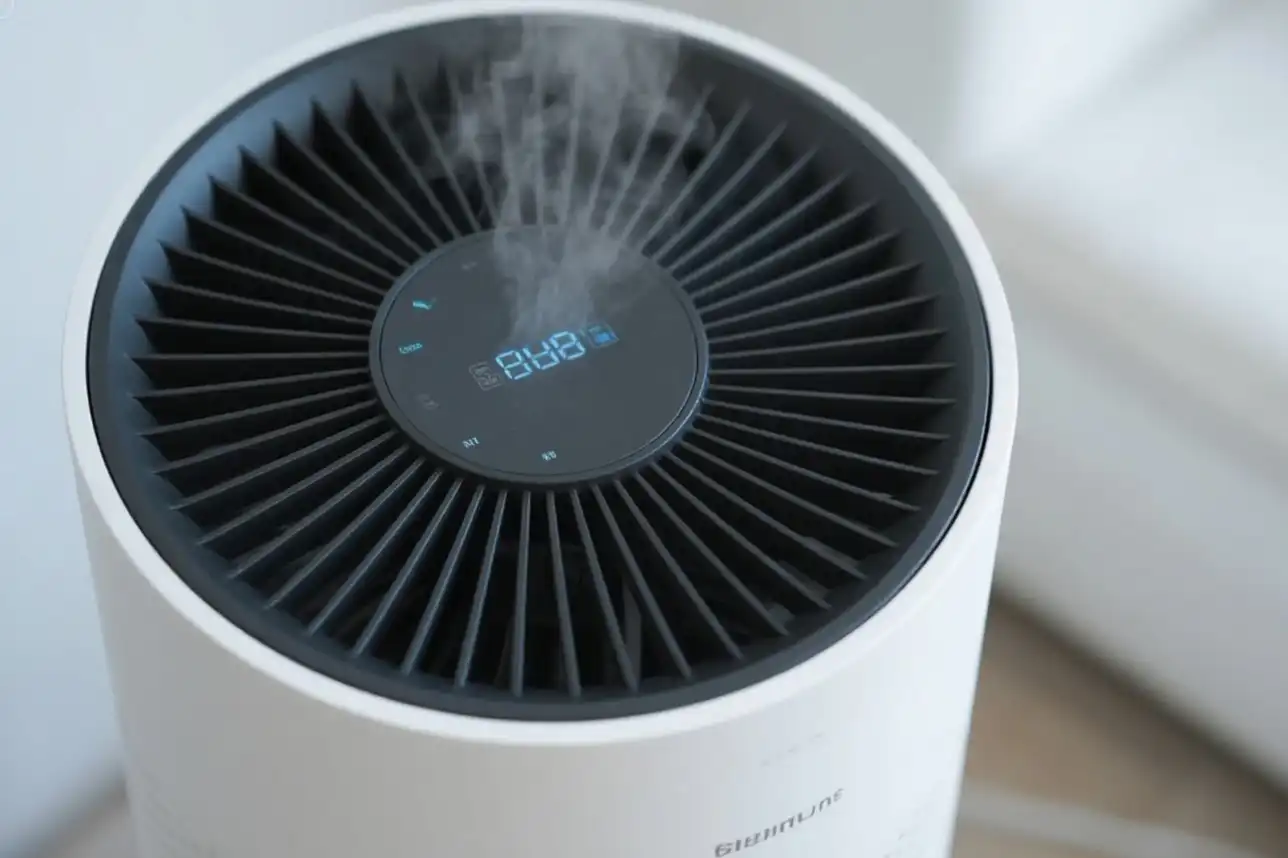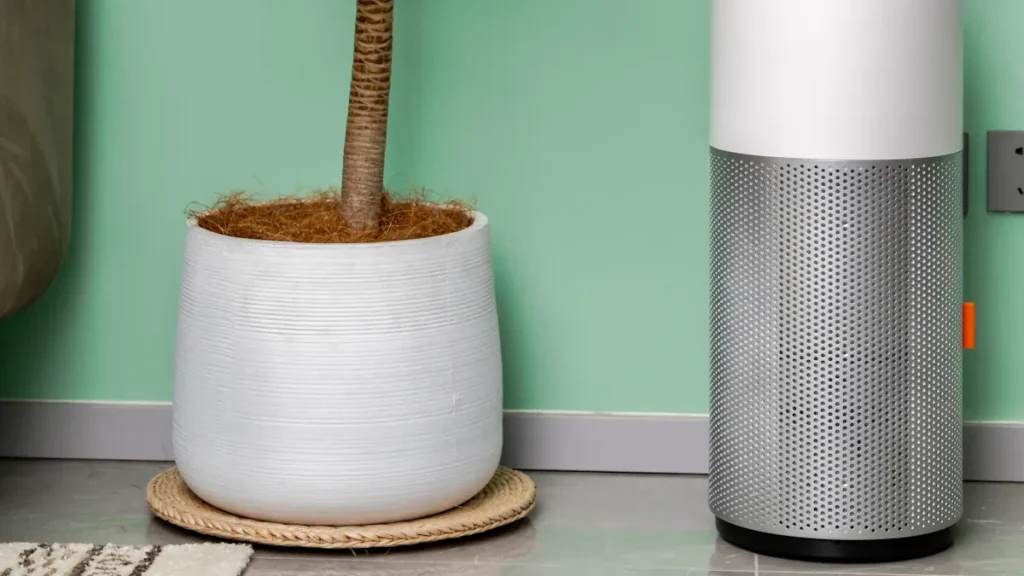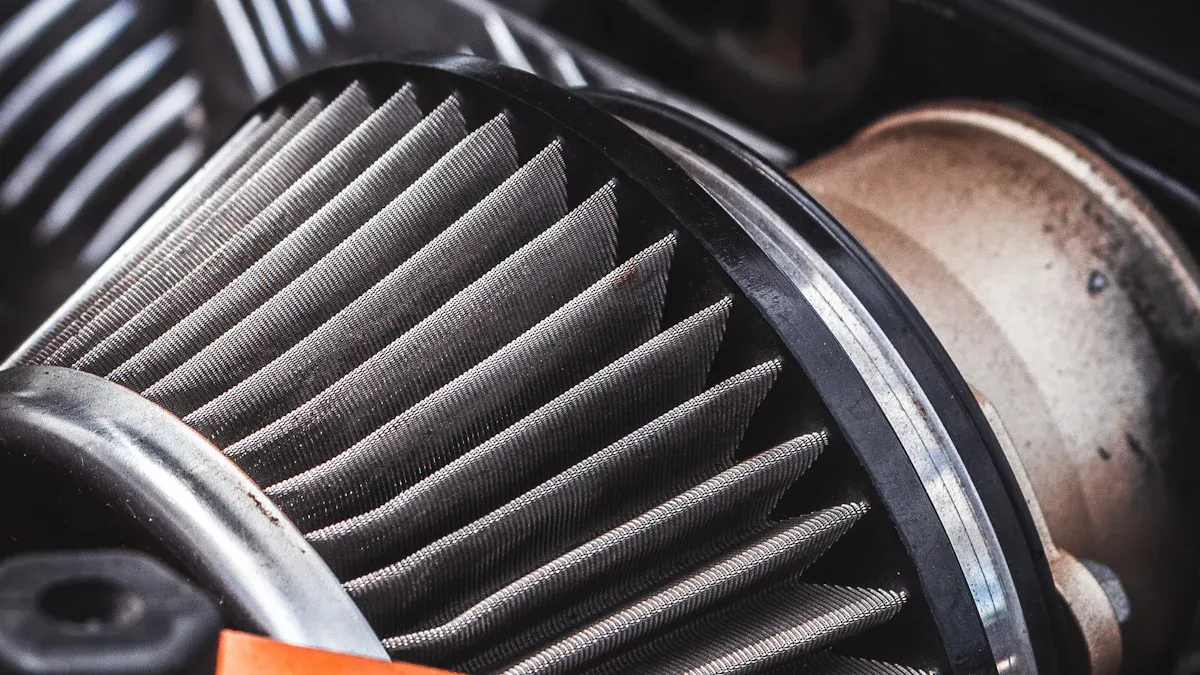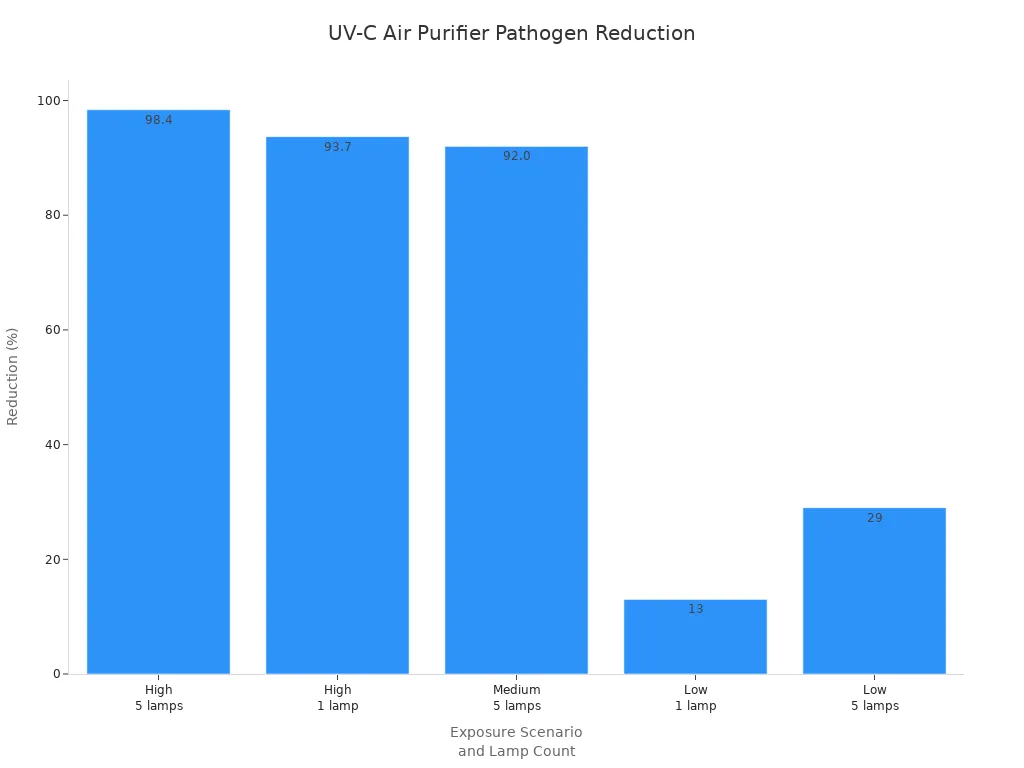
When you switch on an air purifier, it takes in air from your room. It catches many bad particles. It can trap dust, pollen, animal dander, and gases from cleaning products. Studies show that new air purifiers remove a lot of indoor pollutants:
| Pollutant | Removal Efficiency (%) |
|---|---|
| PM2.5 (fine particles) | 29% to 68%+ |
| HEPA filter (0.3 μm) | 99.97% |
| PM10 (larger particles) | Up to 34% |
Cleaner air helps you breathe better. It also makes your home healthier.
Key Takeaways
- Air purifiers take in air from the room. They use fans to move air through filters. These filters catch dust, pollen, and bad particles.
- Pre-filters grab big pieces of dirt. HEPA filters trap very small bits. Activated carbon filters take away smells and gases.
- Some purifiers use UV light to kill germs. Some use ionizers to drop particles. But filters and airflow are safer to use.
- Clean air helps you breathe better. It lowers allergy problems. It makes your home healthier and fresher.
- Cleaning and changing filters often keeps your purifier strong. This also saves energy and money.
Inside the Air Purifier

Air Intake
When you turn on your air purifier, it starts by pulling air from your room into the device. The air enters through vents or grills on the sides or bottom. This step is important because it brings in the air that needs cleaning. The fan and motor inside the air purifier create a steady flow, drawing in air from all parts of the room.
Tip: Place your air purifier in an open area for better air intake. Avoid blocking the vents with furniture or curtains.
You can see how airflow rates change based on room size and model in the table below:
| Space Type | Floor Area (sq ft) | Ceiling Height (ft) | Air Exchange Rate (per hour) | Airflow Rate Needed (CFM) |
|---|---|---|---|---|
| Small Room | 200 | 8 | 3 | 163 |
| Whole House | 2000 | 8 | 0.5 | 272 |
Some large air purifiers, like the MAX-Guard HEPA, can move up to 900 cubic feet of air per minute. This helps clean the air faster in bigger spaces.
Fan and Motor
The fan and motor are the heart of your air purifier. The fan, powered by a motor, pushes air through the filters. This action lets the filters catch dust, pollen, and other particles. Most air purifiers use a brushless DC motor, which is quiet and energy-efficient.
- The fan controls how much air moves through the purifier.
- Higher fan speeds increase the Clean Air Delivery Rate (CADR).
- The sealed fan housing keeps air from leaking out, so all air passes through the filters.
- The motor may release a tiny amount of particles, but this is less than 0.1% of what the purifier removes.
Continuous air circulation is key. Your air purifier keeps pulling in and cleaning air over and over. This process lowers the number of harmful particles in your room. The filtered air goes back into the room, making the air cleaner each time it passes through the device.
You might wonder about energy use. Air purifiers are energy-efficient compared to other home appliances. Look at the chart below to see how they compare:
Most air purifiers use between 30 and 100 watts. This means you can run your air purifier all day without worrying about high energy bills.
Filtration Process

When you look inside an air purifier, you see several filters. Each filter does a different job. The air goes through these filters one after another. This process takes out dust, allergens, odors, and gases from your room.
Pre-Filter
The pre-filter is the first filter the air touches. It acts like a guard at the door. It grabs the biggest particles before they go further. Here is what the pre-filter does:
- It catches large things like dust, pet hair, lint, carpet fibers, and dander.
- It stops these things from blocking the main filter, so the air purifier lasts longer.
- It helps make the air better by removing things that can cause allergies or asthma.
- It uses materials like foam, polyester, nylon mesh, or fiberglass.
- Some pre-filters can be washed or used again, so they are easy to care for.
- It grabs about 20% to 70% of particles between 3 and 10 microns in size.
- It removes most things bigger than 5 microns, like pollen and hair, very well (often above 80%).
Note: You should clean or change the pre-filter often. This keeps your air purifier working well and saves money on main filter changes.
HEPA Filter
After the pre-filter, the air moves into the HEPA filter. This filter is the main shield against tiny particles. HEPA means High-Efficiency Particulate Air. You find this filter in most good air purifiers.
A HEPA filter removes at least 99.97% of particles as small as 0.3 microns. This size is hard to catch. The filter works in a few ways:
| Mechanism | Particle Size Range | How It Works |
|---|---|---|
| Diffusion | < 0.1 µm | Tiny particles move around and bump into fibers, getting trapped. |
| Interception | 0.1 – 1.0 µm | Particles follow the air but stick to fibers when they get close. |
| Inertial Impaction | > 0.5 – 1.0 µm | Bigger particles cannot turn with the air and hit the filter fibers. |
These ways help the HEPA filter trap dust, pollen, mold spores, and some bacteria. The filter acts like a very fine net. Air goes through, but harmful particles stay behind.
Tip: HEPA filters do not remove gases or odors. They only catch solid and liquid particles in the air.
Activated Carbon
The last main filter is the activated carbon filter. This filter targets things you cannot see or smell right away. It removes gases and odors that the HEPA filter cannot catch.
Activated carbon filters use a process called adsorption. Pollutants stick to the surface of the carbon, which has many tiny holes. Here is what this filter removes:
- Volatile Organic Compounds (VOCs) from cleaning products, paints, and personal care items.
- Chemical fumes and gases from cooking or household materials.
- Odors from food, pets, mustiness, and smoke.
- Ozone, which can cause breathing problems.
- Smoke odors from cigarettes, wildfires, and burnt food.
Activated carbon filters work best for VOCs and many household odors. They do not remove carbon monoxide well, but they can lower ozone and many other gases. How much they can adsorb depends on the type of carbon and the pollutant.
Note: Activated carbon filters need to be changed often. They stop working as well when they fill up with pollutants.
Purification Technologies
UV Light
Some air purifiers use UV light technology. UV-C light has a wavelength of about 254 nanometers. This light can kill germs by breaking them apart. When air moves past the UV lamp, the light shines on bacteria and viruses. The strong UV-C light breaks the DNA inside these germs. This stops them from making more germs or spreading sickness.
Here is how UV-C light works:
- UV-C light shines on germs like bacteria and viruses.
- The DNA inside the germs takes in the light.
- The DNA breaks and cannot do its job anymore.
- The germs stop working and cannot make you sick.
Note: UV-C light works best if germs get enough time under the light. Some tough germs, like spores, need more time to be destroyed.
Lab tests show UV-C light can lower germs in the air by over 90%. In some tests, using more UV lamps cut germs by 98.4% in just a few minutes.

Ionizer
Ionizers clean air in a different way using electricity. They send out negative ions into the room. These ions stick to dust, pollen, and other tiny particles. The particles join together and get heavier. They fall onto floors, walls, and furniture.
You need to clean these surfaces often. If not, the particles can go back into the air. Ionizers do not trap particles inside the device. They help remove them from the air you breathe.
⚠️ Caution: Ionizers can make things like ozone and other chemicals. These can cause breathing problems or other health issues. Experts say filters and good airflow are safer choices.
Other Advanced Technologies
Some air purifiers use special methods like Streamer Discharge. This uses fast electrons to break down bad things in the air. Each method has good and bad points.
| Technology | Main Function | Effectiveness and Limitations |
|---|---|---|
| HEPA Filters | Trap particles including allergens and pathogens | Capture 99.97% of particles; safe; no ozone; need regular filter changes |
| UV Light | Inactivate germs by damaging DNA/RNA | Effective against bacteria and viruses; needs direct exposure; may emit ozone |
| Ionizers | Charge particles to make them settle on surfaces | Moderate efficiency; can reduce odors; may create ozone and surface contamination |
Clean Air
Air Output
After the air passes through all the filters and purification steps, it leaves the device as clean air. The fan pushes this purified air back into your room. You notice the difference as the air feels fresher and smells better. The Clean Air Delivery Rate (CADR) tells you how much filtered air comes out each minute. CADR measures the volume of clean air, combining filter efficiency and airflow. You can use this number to compare different devices. A higher CADR means more clean air for your space.
Tip: Choose a device with a CADR that matches your room size. For example, if your room is 240 square feet, look for a CADR of about 160 CFM. This helps you get the best results.
You can see how much air quality improves after using a device. Studies show that after installing a filtration system, rooms had 50-60% less particulate matter and fewer odors. Some devices reduce PM10 by about 90% and PM2.5 by around 80%. These numbers show that the air you breathe becomes much cleaner.
| Pollutant | Reduction Percentage |
|---|---|
| PM10 | ~90% |
| PM2.5 | ~80% |
Benefits
Clean air brings many benefits to your health and comfort. You breathe easier and sleep better. If you have allergies or asthma, you may notice fewer symptoms. HEPA filters trap tiny particles like pollen, dust mites, and mold spores. This lowers your exposure to things that can make you sick.
- You get relief from allergy and asthma symptoms.
- You reduce your risk from urban pollution and airborne viruses.
- You enjoy a fresher-smelling home.
- You protect your lungs from harmful particles.
Several studies show that using a device with HEPA filters can cut indoor pollutants by 50% to 80%. People with asthma or allergies often feel better after weeks or months of use. You get the most benefit when you use the device in bedrooms or other rooms where you spend a lot of time. For best results, combine air cleaning with regular cleaning and good home habits.
Maintenance
Filter Replacement
You need to change filters on time to keep your air purifier working well. Each filter lasts for a different amount of time. The table below shows when to change each one:
| Filter Type | Recommended Replacement Frequency | Notes |
|---|---|---|
| HEPA Filters | 6 to 12 months | Replace sooner if you have pets, allergies, or high pollution. |
| Activated Carbon | About once a year | Change more often if odors linger. |
| General Guidelines | Follow manufacturer instructions | Many purifiers have filter replacement indicators. |
| Visual Inspection | As needed | Look for dirt, discoloration, or damage. |
| Replacement Schedule | Set reminders | Use a calendar or phone to track filter changes. |
Always follow the manufacturer’s advice for your model. If you have pets or allergies, change filters more often. Changing filters often keeps your air purifier strong. If you forget to change them, dust can block the airflow. This can cut the clean air delivery rate (CADR) in half. It also lowers how well the purifier removes harmful gases. Over time, the device works harder and uses more energy. It may break down sooner. You could also breathe in more dust, allergens, and even mold.
Tip: Set a reminder on your phone or calendar to change filters. This helps you avoid repairs and keeps your air healthy.
Cleaning Tips
You can keep your air purifier in good shape with simple cleaning steps:
- Change HEPA and carbon filters as the manual says.
- Clean washable pre-filters every month or when dirty.
- Wipe the outside and air vents with a damp cloth.
- Make sure nothing blocks the air intake or output.
- Put the purifier in a closed room to stop outside air.
- Keep the area around the purifier clear for better airflow.
Cleaning and changing filters help your air purifier last longer. You save money by avoiding big repairs. You also protect your health by lowering dust, allergens, and odors in your home. If you skip maintenance, you might pay more for energy. The air quality can get worse. You could even have more allergies or asthma attacks.
🛠️ Note: Most filter changes and cleaning jobs are easy to do yourself. For whole-house systems, you may need a pro to keep your warranty.
You can see how clean air happens step by step inside your device:
- Air enters through the intake.
- Pre-filters catch large dust and debris.
- Main filters trap fine particles and allergens.
- Activated carbon removes odors and gases.
- Clean air flows back into your room.
Cleaner air means less coughing, better sleep, and fewer allergy symptoms. Sensitive groups feel safer. Remember to change filters and clean your unit often for the best results.
FAQ
What does a HEPA filter remove from the air?
A HEPA filter removes dust, pollen, mold spores, pet dander, and some bacteria. You get cleaner air because it traps 99.97% of particles as small as 0.3 microns.
What happens if you do not change the air purifier filter?
If you do not change the filter, it gets clogged. You will notice less airflow and poor air cleaning. Dirty filters can even release trapped particles back into your room.
What is the difference between a HEPA filter and an activated carbon filter?
A HEPA filter catches solid particles like dust and pollen. An activated carbon filter removes odors and gases. You need both for the best air cleaning results.
What should you avoid when using an air purifier?
You should avoid blocking the air intake or output. Do not place the purifier behind furniture or curtains. Keep the area around the device clear for better airflow.
What does the Clean Air Delivery Rate (CADR) mean?
CADR tells you how much clean air your purifier delivers each minute. You can use this number to pick the right purifier for your room size.
See also
Uncovering the Truth About Air Purifiers and Their Safety
What Size Air Purifier Is Needed for Bedrooms, Living Rooms, and Offices
